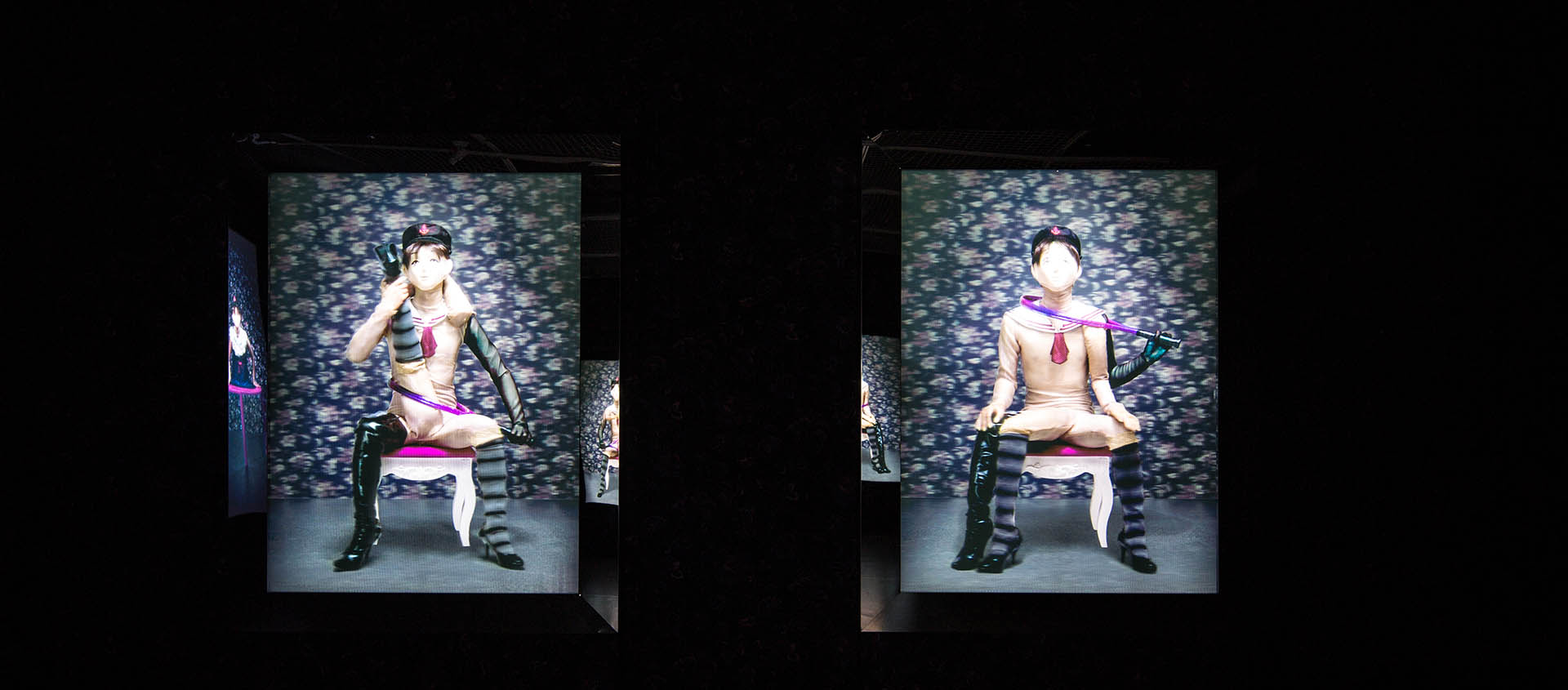

台北當代藝術館 官方網站 Museum of Contemporary Art, Taipei
Sunday 星期日
10AM - 6PM



Sunday 星期日
10AM - 6PM
EXHIBITIONS & EVENTS 展覽活動

2014 / 03 / 29 Sat.
2014 / 05 / 04 Sun.
10:00 - 18:00
地點
Venue
MoCA Studio
【喚‧魅─吳天章個展】是吳天章不斷推衍自我藝術生涯的又一次公開展示;早在80年代後期,他以充滿新本土意象的平面繪畫系列崛起藝壇,2000年初他毫不戀棧、重起爐灶似的快速轉進到數位平面影像這個新興的創作領域,從中完成了許多膾炙人口的作品,之後他又再度挑戰自我,開闢了目前結合「動態影像」和空間劇場概念的一條創作新路線。 本次當代藝術館的【喚‧魅─吳天章個展】,充分展現了吳天章偏好拼裝/複合兩極對立事物/意象的藝術思維和創作特質。以作品的生產為例,他一面訴諸原始的手工和勞動的精神,自行設計生產演出所需的服裝和道具,另一面卻又精心結合了新科技的「電控液晶玻璃」素材和機械投影技術,蓄意將展出現場營造出一種魔幻劇場的聲光氛圍和視覺體驗。再以本展所有動態影像作品的拍攝為例,他以極低限的態度運用數位影像媒材,放棄採用時下相當方便的電腦編修及後製軟體,而堅持了現場演出、一鏡到底的攝製手法,雖然因此增加了創作的難度,並降低了讓作品更完整無瑕的機率,但也因此,我們看到這些作品在利用數位科技的同時,其實隱藏了反思與審視當代科技文明的一道人文機制。 就創作意念而言,吳天章長期關注普存於台灣生活環境中,藉由「假假的視覺」而呈現的集體潛意識,以及充斥於社會文化中的一種「僞造」性格;在實作上,他刻意將真/假、虛/實以及生/死等相對立的題材和概念同時擺置於臨界點上,並透過虛實交替的「光學魔術」和「道具特技」,創造出詭異驚悚的動態視覺風格,同時演繹一場狡黠的辨證美學。「魔術」的本質就是假,卻讓觀者無法否認他所看到的真實;「特技」剛好顛倒,一切都是真功夫的,但因讓人捏把冷汗而寧願其中有假。吳天章的作品和展覽呈現,有意在這視覺的錯亂和知覺的動念之間著墨,召喚隱存在於吾人心靈意識中,對這種不可名狀之魅力的一種期待! 歷史的真實往往被隱藏,以一種「偽裝」的樣貌續存且被看見,長久處於殖民與被殖民的歷史幽魂拉鋸,塑造了台灣的一種掠奪心態、失序社會和集體焦慮。身為一個從歷史與文化批判意識起家的創作者,吳天章秉持著「去菁英」的姿態,極力跳脫「議題式」的創作窠臼,而回歸到社會美學層面的觀照,將台灣「聳、俗」的常民文化及生命信仰符碼,轉譯為具當代性的視覺元素,以黑色幽默的氣質,和「返璞」的精神來召喚一種無法「歸真」的歷史記憶、以及仍然斷裂中的主體認同,希望以此重新連結台灣的土地倫理和人文情感。 Magical Limbo – Solo Exhibition of Wu Tienchang is yet another public demonstration of Wu Tienchang’s continuous effort at expanding his own artistic horizons. The late 80s saw his rise in the Taiwanese art scene with paintings of neo-localist imagery; at the beginning of 2000, seemingly without a backward glance, he shifted to the burgeoning medium of digital imaging, and created prominent artworks. Since then, he has once again challenged himself, developing a new creative path by integrating moving image and theatrical space. The exhibition at MoCA, Taipei showcases Wu’s penchant for the artistic through-line/creative style of remixing and juxtaposing material and images. Take the production of his artworks as an example: on the one hand, the artist singlehandedly designed and created the costumes and props needed for the performances, adhering to the tradition of handmade craftsmanship and pre-technological labor; on the other hand, he also incorporated such new technologies as liquid crystal glass and mechanical projection into the pieces in order to foster a sense of fantastical theatricality in the audience’s audio-visual experience. Another example can be seen in the filming process of all the video content in the exhibition. Wu took a minimalistic approach in the use of digital imaging media, discarding commonly used conveniences such as computerized editing and postproduction programs in favor of live performances and one-take recordings. As the creative process became more difficult, the chances for completeness and perfection in the end product were low. The approach highlighted the fact that while incorporating digital technology, the artworks also conceal a cultural mechanism with which to examine the modern tech-heavy civilization. In terms of general creative impetus, Wu’s long-term focus is on the Taiwanese collective subconscious as presented through “fake-y visuals,” as well as a certain counterfeit-prone mentality common in Taiwanese culture. Applied to his works, the artist deliberately places such opposing subjects and concepts as real/fake, illusion/reality and life/death at their tipping point, and creates a bizarre and chilling visual style through optical magic tricks and prop-based acrobatics. The result is a demonstration of contrasting discourses in sly artistic debate. Artificiality is at the core of magic tricks, but viewers usually cannot easily deny the reality they see; acrobatics is the exact opposite, because while the performance is built out of real training and work, the tremendous perceived risk often makes viewers hope for some unseen falsity. Wu’s works and overall presentation deliberately tap into the space between the visual confusion and cognitive dissonance, conjuring the viewer’s own hidden craving for this kind of unknowable charm. The realness of history is often hidden, only seen and existing as a kind of disguise. The Taiwanese, long caught in a tug-of-war between the haunted histories of the colonial and the post-colonial, has developed a predatorial instinct, a chaotic society and a collective anxiety. As an artist whose roots are in historical and cultural critique, here Wu takes a non-elitist stance and strives to bypass the pitfalls of issue-oriented art. Instead, he returns to socio-aesthetic observations and reflections, translating the lowbrow Taiwanese popular culture and religious codes into contemporary visual elements. With a dark sense of humor and the spirit of “going back to basics”, the artist summons an unreconstructable historical memory and an as-yet crumbling identity, hoping thus to reconnect with the cultural feelings and land ethics of Taiwan.
MORE
LESS
1956年生於台灣彰化,1980年畢業於中國文化大學美術系。
80年代時,以充滿新本土意象的平面繪畫系列崛起藝壇,作品談論「政治、歷史」等主題,被譽為台灣藝壇「解嚴」的第一人。90年代,改以攝影複合媒材為媒介,開啟充滿台灣文化風味的「台客美學」系列攝影創作。2000年初,蓬勃發展的電腦攝影修圖及合成技術也成為他研究與創作的工具,透過肢體設計和準確度的要求,以「安排式攝影」製作出許多驚聳有力且膾炙人口的影像作品。2010年後又再度挑戰自己,踏入動態影像領域,以「一鏡到底」、「抽格」、「快速攝影」等的拍攝手法,以及展出現場的互動與機關設置,呈現詭異的視覺觀影氛圍,也開闢了結合動態影像和空間劇場概念的一條創作新路線。
Born in Changhua, Taiwan in 1956, Wu Tienchang graduated from the Department of Fine Arts, Chinese Culture University in 1980.
In the 1980s, Wu launched his artistic career with his neo-localist paintings. His works touched upon “politics and history,” and he was hailed as the first artist to “abolish martial law” in Taiwan. In the 1990s, he used mixed media photography to create a series of photographs incorporating “Tai-ke aesthetics.” In early 2000, he employed computer-aided editing and designing into his works. Through choreography and precision, Wu’s “staged photography” produced many impressive and phenomenal images. Since 2010, Wu has challenged himself with video works. He uses techniques such as “long take,” “skip framing,” and “high speed photography” along with onsite interactive devices to present a peculiar visual atmosphere, introducing his new style of combining videos and concepts of theatrical space.
CLOSE
CLOSE
著作權聲明
台北當代藝術館尊重他人著作權,台北當代藝術館服務條款亦明定,網友使用台北當代藝術館服務不得侵害他人之著作權,因此,台北當代藝術館呼籲使用者同樣尊重他人之著作權。如果您認為台北當代藝術館網站中之任何網頁內容或網友使用台北當代藝術館服務已侵害您的著作權,建議您利用本處理辦法提出檢舉,台北當代藝術館客服中心將儘速為您處理:
若台北當代藝術館網站中之任何網頁內容或網友使用台北當代藝術館服務已侵害您的著作權,請您填寫:「 著作權侵權通知書」,且依該通知書所載提供下列資料及聲明,並以傳真的方式通知台北當代藝術館:
1、著作權人之簽名、或著作權人之代理人之簽名、相關權利證明文件及著作權之內容,例如:已發行書籍之封面及相關頁面、發表於網路中之網頁內容列印紙本及其網址。
2、侵害著作權之內容所在的網頁及網址。
3、您的聯絡地址、電話等資料。
4、書面聲明您確信該網頁內容的使用行為是未經過著作權人、其代理人或法律的授權。
5、書面聲明您於通知書所載相關資料均為真實,且您是著作權人或著作權人之代理人而為上開聲明。
若台北當代藝術館網站中之任何網頁內容或網友使用台北當代藝術館服務已侵害您的著作權,請您填寫:「 著作權侵權通知書」,且依該通知書所載提供下列資料及聲明,並以傳真的方式通知台北當代藝術館:
1、著作權人之簽名、或著作權人之代理人之簽名、相關權利證明文件及著作權之內容,例如:已發行書籍之封面及相關頁面、發表於網路中之網頁內容列印紙本及其網址。
2、侵害著作權之內容所在的網頁及網址。
3、您的聯絡地址、電話等資料。
4、書面聲明您確信該網頁內容的使用行為是未經過著作權人、其代理人或法律的授權。
5、書面聲明您於通知書所載相關資料均為真實,且您是著作權人或著作權人之代理人而為上開聲明。
隱私權保護政策
台北當代藝術館非常重視用戶的隱私權,因此制訂了隱私權保護政策。請你細讀以下有關隱私權保護政策的內容。
隱私權保護政策的適用範圍
1、隱私權保護政策內容,包括台北當代藝術館如何處理在用戶使用網站服務時收集到的身份識別資料,也包括台北當代藝術館如何處理在商業伙伴與台北當代藝術館合作時分享的任何身份識別資料。
2、隱私權保護政策不適用於台北當代藝術館以外的公司,也不適用於非台北當代藝術館所僱用或管理的人員。
3、台北當代藝術館在你註冊台北當代藝術館帳號、使用台北當代藝術館的產品或服務、瀏覽台北當代藝術館網頁、參加宣傳活動或贈獎遊戲時,台北當代藝術館會收集你的個人識別資料。台北當代藝術館也可以從商業夥伴處取得個人資料。
4、當你在台北當代藝術館註冊時,我們會問及你的姓名、電子郵件地址、出生日期、性別、職位、行業及個人興趣等資料。你在台北當代藝術館註冊成功,並登入使用我們的服務後,我們就會認識你。
5、台北當代藝術館也自動接收並紀錄你瀏覽器上的伺服器數值,包括互聯網協定位址 (IP Address) 、台北當代藝術館cookie中的資料及你要求取用的網頁紀錄。
6、台北當代藝術館會使用資料作以下用途:改進為你提供的廣告及網頁內容、完成你對某項產品的要求及通知你特別活動或新產品。
7、台北當代藝術館不會向任何人出售或出借你的個人識別資料。
8、在以下的情況下,台北當代藝術館會向政府機關、其他人士或公司提供你的個人識別資料:與其他人士或公司共用資料前取得你的同意。
9、需要與其他人士或公司共用你的資料,才能夠提供你要求的產品或服務。
10、向代表台北當代藝術館提供服務或產品的公司提供資料,以便向你提供產品或服務 (若我們沒有事先通知你,這些公司均無權使用我們提供的個人資料,作提供產品或服務以外的其他用途)。
11、應遵守法令或政府機關的要求。
12、我們發覺你在網站上的行為違反 台北當代藝術館服務條款或產品、服務的特定使用指南。
13、其他依「個人資料保護法」或政府法令應公開之資料。
14、為了保護使用者個人隱私, 我們無法為您查詢其他使用者的帳號資料,請您見諒!若您有相關法律上問題需查閱他人資料時,請務必向警政單位提出告訴,我們將全力配合警政單位調查並提供所有相關資料,以協助調查及破案!
15、 台北當代藝術館會到你的電腦設定並取用台北當代藝術館cookie。
16、台北當代藝術館容許在我們網頁上擺放廣告的廠商到你的電腦設定並取用cookie。其他公司將根據其自訂的隱私權保護政策,而並非本政策使用其cookie。其他廣告商或公司不能提取台北當代藝術館的cookie。
17、當台北當代藝術館進行與其產品及服務有關的工作時,會使用 web beacons 進入我們的網站網絡,提取cookie使用。
18、台北當代藝術館賦予你在任何時候修改個人台北當代藝術館帳號資料及偏好設定的權力,包括接受台北當代藝術館通知你特別活動或新產品的決定權。